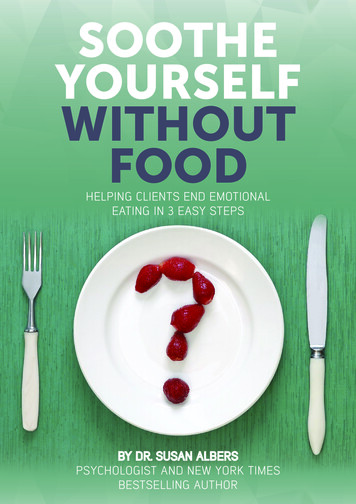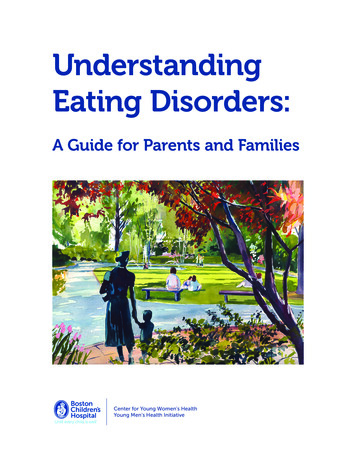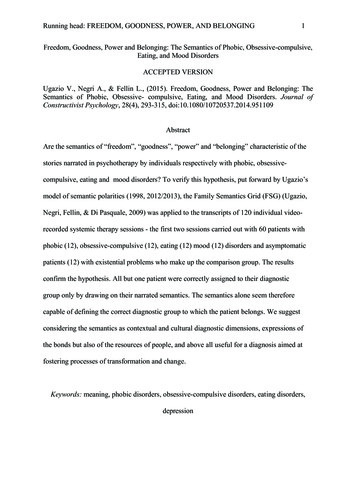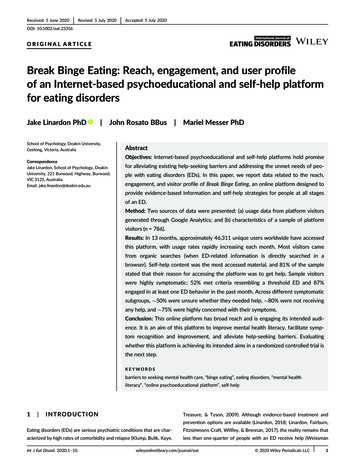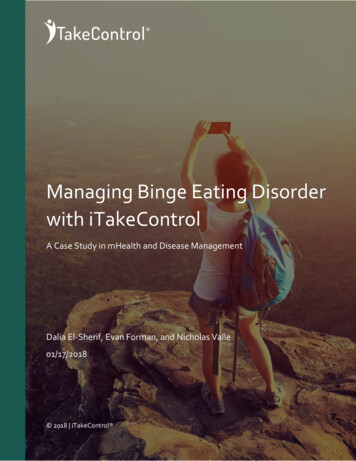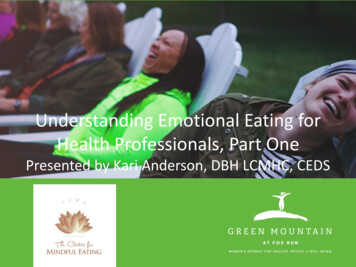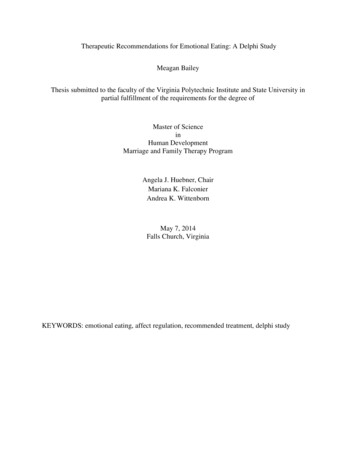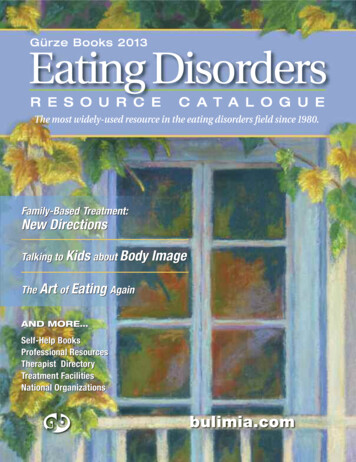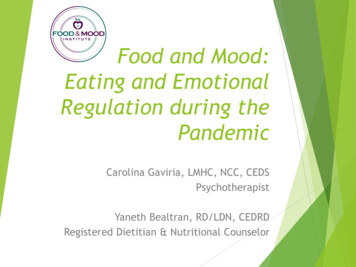
Transcription
Food and Mood:Eating and EmotionalRegulation during thePandemicCarolina Gaviria, LMHC, NCC, CEDSPsychotherapistYaneth Bealtran, RD/LDN, CEDRDRegistered Dietitian & Nutritional Counselor
Carolina Gaviria, LMHC, NCC,CEDS I'm a bilingual Psychotherapistwho specializes in eatingdisorders, substance abuse andtrauma. I work with children,teens and adults and their familieshelping them identify theirstrengths and internal resources tofind and maintain recovery.
Yaneth Bealtran, RD/LDN,CEDRD I’m a bilingual nutritionistwho takes a holisticapproach to wellnessproviding nutritionalcounseling to people whobelieve in the power of thetherapeutic relationshipbetween clients andprofessionals. I guide andsupport people in theprocess of finding balancewithin their bodies, foodand lives.
In this workshop you willlearn: The meaning of emotional eating The basic behaviors that describe emotional eaters The signs and symptoms of emotional eating Some causes of emotional eating Strategies for breaking away from emotional eating Resources for ongoing support
What is Emotional Eating? Have you ever foundyourself standing in frontof the refrigeratorlooking for something toeat when you weren’thungry? Are there times whenyou’ve had a snack, eventhough you knew youweren’t hungry and youstruggled not to eat itbecause you knew thatyou’d feel guiltyafterward?
What made you eat eventhough you knew youweren’t physically hungry?If we ask with curiosity, notjudgment, most likely theanswer will be: “It was anemotional urge to eat!”
Emotional Urge It means eating in responseto unpleasant emotionalarousal, or occasionally,eating to create a pleasantemotion or make a pleasantemotional state even better(Enhancing emotions). It’s a response to anemotional triggering event
Emotional Eating:Feeding your FeelingsBecause feelingsseem socomplicated and wehave been so poorlyeducated onhandling them, it’seasy to confusethem with hunger!Stop and Feel!
Three basic behaviors describeEmotional Eaters:1. They overeat to suppressuncomfortable feelings.2. They choose comfort foods (notbroccoli or carrots!) and feelguilty after eating them.3. They don’t have other coping toolsor fail to use alternate problemsolving skills.
Signs of Emotional EatingDoes your hunger come on fast as opposed togrowing gradually?If the answer is YES you are eating emotionally!Emotional hunger is often dramatic and sudden, and isusually triggered by an event, feeling or memory.Regular, physical hunger builds slowly, starting with aslight tummy rumble, then a growl, then physicalhunger pangs.
When you got hungry, did you feel adesperate need to eat right away?If the answer is YES you are eatingemotionally!Unlike physical hunger, which willwait for food, emotional hunger isperceived as a DEMAND for foodthat needs IMMEDIATE satisfaction.
When you ate, did you just stuff thefood in quickly or did youovereat?If the answer is YES you are eatingemotionally!Emotional eaters feel urged to eatand the food is stuffed in veryquickly, usually causingovereating.
When hungry, did you crave certain typesof food, like cookies, chocolates, aspecific flavor of ice cream, or aspecial food that requires effort toobtain?If the answer is YES you are eatingemotionally!Emotional hunger demands specificcomfort foods that create a specificfeeling.
After eating, did you feel guilty ordefeated afterward?If the answer is YES you are eatingemotionally!Emotional hunger results in guilt,regret and promises to notovereat again and sometimes,feelings of shame and failure.
Did you eat when you were feelingangry, lonely, stressed, exhausted,ashamed, hurt, or feeling emotionalemptiness?If the answer is YES you are eatingemotionally!Emotional eating results from anemotional trigger; physical hungercomes from a physiological needwith very little emotion attached toit.
Emotional EatingMixed Messages: Food is GOOD – “Finish your homework and get dessert as areward.” Food is BAD – “Be careful – you’re getting fat! Food is a SUBSTITUTE – “My mom and dad keep fighting, soI’ll eat these cookies in my room and will feel better.” “Ihave nothing to do, maybe I can eat some ice-cream”. Food is LOVE – “I love you, I feed you!” – memoriesassociated with food!
Mixed Messages CreateAmbivalence “On one hand, I want to lose weight and control myeating to be “healthy”, but on the other hand I’ll feeldeprived of my favorite foods (emotional fear andfrustration)” Ambivalence is resolved when the benefits of the newbehavior outweigh the costs of the old behavior!
Emotional Avoidance:Fear of FeelingsThis fear often develops early in life: Expression of feelings isdiscouraged or unsafe The fear makes you avoid painfulemotions at any cost becauseyou’re scared to face them Avoiding feelings makes themworse
Triggers for Emotional EatingHormonal Influences: Sugar cravings – can be related to low cortisol (ahormone in the brain that gets depleted by stress) Carbohydrate cravings – problems with serotonin levels(a hormone in the brain that regulates mood, appetiteand perception) Depression – can be related to estrogen/progesteronebalance, low cortisol, or thyroid levels Stress – can be related to problems with cortisol levels Anxiety – estrogen/progesterone balance; high cortisol;thyroid problems
Chronic Stress & EmotionalEating Can release hormones like adrenaline andcortisol that impair perception, mood,hormonal balance and health Can impact mood regulating hormones in thebrain Can lead to adrenal fatigue and seriousphysical health problems Can trigger serious mental disorders such asanxiety, depression and OCD Can impact self esteem and fear of failure Can lead to weight gain and increase tendencyto store visceral fat around middle of body
The Cycle ofEmotional EatingFeelings of GuiltAnd Failure –Creates morestressStressful lifeevent/situationCore Causes: Early Learning Food as substitute Feelings Phobia Hormonal IssuesEmotionalEating EpisodePainfulEmotionsRunning fromFeelings withFood-Avoidance-
Breaking Away from EmotionalEating: Finding Freedom,enjoying food and dealing withyour emotions! Managing feelings Mindful eating Stress management Healthy habits Alternate strategies for self-care Treatment team includes physician, psychotherapist,nutritional counselor and psychiatrist
Facing the FeelingsIt starts with: Recognizing that emotional eating usually has aprecipitating event that triggers an unpleasant or painfulfeeling Reassessing our attitudes toward emotions Emotions are not good or bad E-motions are just “energy in motion” and this energy canbe redirected Emotions will change with time and a change of perception Emotional tolerance, emotional regulation and feelingmanagement can be learned and get better with practice
Feelings are NOT Facts“We’re not supposed to feel good all the time; it's simply notpossible. You have a range of emotions that come and goand that's the way life is supposed to work. The truth is,there's actually no such thing as a “bad” feeling. By labeling afeeling negatively, what you mean is that it causes you to feelbadly (that is, not pleasurably), or that experiencing it makesyou feel as if you're a bad person. Feelings are feelings, justas colors are colors and musical notes are musical notes(and food is food).” from the workbook “Food and Feelings, a Full Course Meal onEmotional Health” from Karin R. Koenig, LCSW, M.Ed
Increasing Awareness ofFeelings Learn to identify feelings Use word lists Pay attention to howemotion feels in your body When the urge to eat hitsother than food?” Choose emotional copingstrategies ahead of time Find alternate strategiesso you’re not caught offguardsuddenly, ask yourself: Keep a journal of what“Am I really hungry or isthis an emotion disguisedworksas hunger?”; “What other Manage emotions withstrategies for taking caremindfulness techniquesof my emotions can I use
Managing Your FeelingsFeelings and the “food trance”: The “food trance” is an escape state In the “trance”, bad feelings are transformed intothe pleasure of eating Unpleasant or painful emotions are triggered andavoidance and fear stops you from dealing with themdirectly The rational brain shuts down and mindless oremotional eating occurs, followed by guilt, shame and asense of loss of control and failure The trance can be overcome with Mindful Eating
What Is Mindful Eating? Engaging our rational mind to stayaware of our thoughts and feelingsas we eat Being aware of all of our senses aswe eat Allowing sufficient time to eat Listening to your body for physicalhunger and fullness cues Discovering alternate “feel-good”states other than the “foodtrance”
Mindful Eating Behavior Check in with your body and internal cues to determineyour levels of hunger and fullness Check in for any emotions arising and identify them inyour body – name them Take time to engage your five senses and look, touch,smell, taste and listen to the food you have in front ofyou and in your mouth Chew slowly, savoring each bite Be aware of how you feel while you are eating Remind yourself that you have alternative strategies formeeting your emotional needs Give yourself permission to enjoy your food!!Adapted from Breaking Free from Emotional Eating by Geneen Roth
Mindful Eating Remember that physical hunger isnormal and develops gradually Give yourself permission to leavefood on plate if you are experiencinglevels of satisfaction Eat in full view of others – no secreteating Sit down when you eat Eat without distractions Avoid emotional conversations whenyou eat – keep the table a sacredplace to enjoy food! Create a lovely eating environment Tell yourself, “I choose to eat this”
Stress ManagementIt includes: Increasing self-awareness Using relaxation techniques to managestress effectively Setting healthy boundaries Recognizing and challenging negativethinking Recognizing your own limits and lettinggo of those things that you can’tcontrol Nurturing your interests and spiritualgrowth Limiting contact with negative people
Healthy Mind-Healthy BodyExerciseSleep wellGet annual physical examTake care of your mental health andlearn healthy ways of coping Adjust your expectations of weight andbody image based on age and stage oflife Expand your notion of beauty! Follow a well balanced meal plan andtake multi-vitamins, and supplementsif appropriate
Self Care is NOT Selfish!!Instead of using only food for emotional“medication”, find alternate strategies forself-care and nurturing: Practice awareness of your body, youremotions, and your thoughts Learn to identify emotions. Labeling emotionshelps to decrease their intensity. Practice assertiveness to ask for what youneed and want from others Increase your social support Find ways other than eating to get your needsmet (i.e Make a list of alternate “needmeeting” strategies) Identify individual coping strategies that workfor you
Healthy CyclePracticeNew Skills Ready for NextLifeEvent!FeedPhysicalHunger withNutritiousFoodStressfulLifeEventCORE SKILLS: Manage Feelings Mindful Eating Stress Mgmt. Health Mgmt. Alternate Self-CareMindful EatingHealthy CopingSkills
Resources: Book: Eating In the Light of The Moon by Anita Johnston,PHD Books by Geneen Roth:Women, Food and God: An Unexpected Path to AlmostEverythingWhen Food Is Love: Exploring the Relationship Between Eatingand IntimacyLost and Found: Unexpected Revelations about Food andMoneyBreaking Free from Emotional EatingWhen You Eat at the Refrigerator, Pull Up a Chair: 50 Ways toFeel Thin, Gorgeous, and Happy {When You Feel Anything But} The Food and Feelings Workbook by Karen R. Koenig The Intuitive Eating Workbook (A New Harbinger SelfHelp Workbook) Paperback – Illustrated, March 1,2017by Evelyn Tribole (Author), ElyseResch (Author), Tracy Tylka Ph.D (Foreword)
Websites Welcome to the International Association of EatingDisorders Professionals Foundation! (iaedp.com) Home Iaedpsfl (iaedpsouthflorida.org) National Eating Disorders Association Get Help Today Alliance for Eating Disorders Home - The Body Positive Home The Food & Mood Institute, LLC(thefoodandmoodinstitute.com) * You can use the code50GRATIS to access our courses for free (Spanish andEnglish)
Wrap Up What’sthe one thingyou’ll take away from thiswebinar?
Carolina Gaviria, LMHC, NCC, CEDSPhone: 561.305.2497www.solutionsintherapy.comLocations: 5300 W. Hillsboro BlvdSuite 210Coconut Creek, FL 33073* Sessions available inEnglish, Spanish andOnline
Yaneth Beltran, RD/LDN,CEDRDPhone: 954.773.3139Home Mysite (homeforbalance.com)Locations: 5300 W. Hillsboro BlvdSuite 210Coconut Creek, FL 33073* Sessions available in English,Spanish and Online
Transform Your Relationship withFood & Body Visit https://www.thefoodandmoodinstitute.com/ formore information about our online programs to deepenyour work and heal your relationship with food and yourbody.
Chronic Stress & Emotional Eating Can release hormones like adrenaline and cortisol that impair perception, mood, hormonal balance and health Can impact mood regulating hormones in the brain Can lead to adrenal fatigue and serious physical health problems Can trigger serious mental disorders such as anxiety, depression and OCD


